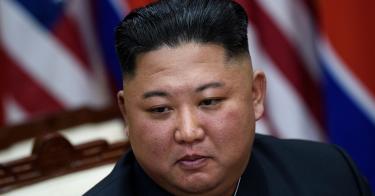Pyongyang continues to augment and diversify its threat to U.S. allies in Asia with mobile missiles more difficult to detect and more adept at evading missile defenses. In September, North Korea revealed three new offensive missiles, a new rail-based launch system, and claimed to have developed a quicker missile fueling system.
The regime is rapidly implementing Kim Jong-un’s January directive to develop and test numerous new missiles. Pyongyang may yet test two new submarine-launched ballistic missiles (SLBM) and a massive multi-warhead ICBM revealed during recent parades. Doing so would significantly escalate tensions in the region and push North Korea to the top of the Biden administration’s security agenda.
New Missiles and Launch Systems Tested
On September 11 and 12, North Korea successfully tested a new long-range cruise missile. North Korean official media declared that the cruise missile flew on a figure-eight pattern to a range of 1500 km (930 miles) and is a “strategic weapon”—usually a reference to being nuclear-capable. The missile has the range to threaten Japan and would augment North Korea’s ballistic missile arsenal intended to intimidate Tokyo from assisting the United States during a Korean conflict. The missile could also be used against targets in South Korea.
Cruise missiles can fly lower than ballistic missiles and with maneuverable, less predictable trajectories to evade missile-defense radars. Cruise missiles can hit their target from any direction, posing difficulties for missile defense systems, such as the Terminal High Altitude Area Defense (THAAD), which do not have 360-degree radar coverage.
>>> North Korea Tests New Long-Range Cruise Missile: What You Should Know
On September 15, North Korea fired two short-range ballistic missiles to a range of 800 km (500 miles) at an altitude of 60 km, suggesting a depressed trajectory more difficult for radars to detect. The new KN-23 variant missiles had a greater range than previous test flights but were most notable for being the first North Korean missiles launched from a train. While dispersing SRBMs on train launchers presents additional targeting challenges for allied war planners, such small solid-fueled missiles are already widely deployed on road-mobile systems.
However, a train-based launcher would be more suitable for large ICBMs, which so far have been test-launched from a limited supply of cumbersome 8- to 11- axle trucks. North Korea’s liquid fueled ICBMs could be transported on trains already fueled thus avoiding long set-up and fueling times prior to launch. The North Korean announcement that the newly-created Railway Mobile Missile Regiment would become a brigade suggests additional missile systems could be deployed on train launchers.
On September 28, North Korea launched a new Hwasong-8 hypersonic glide missile to a range of 200 km (125 miles) at an altitude of 30 km. Pyongyang announced that the missile was one of five top-priority tasks for the development of strategic weapons set forth at the 8th Congress of the Party in January. At that meeting, Kim Jong-un announced North Korea had finished research into “hypersonic gliding flight warheads for new-type ballistic rockets.”
Pyongyang claimed the test successfully demonstrated the missile’s “navigational control and stability…guiding maneuverability and the gliding flight characteristics of the detached hypersonic gliding warhead.” Hypersonic missiles fly at least Mach 5 (five times the speed of sound), and the Hwasong-8 likely has a maneuverable reentry vehicle warhead that detaches from the missile to evade missile defenses. It may have a longer range than the 200 km in the test launch.
North Korea also announced that the missile had the first use of a “missile fuel ampoule,” which would serve as the basis for “turning all missile fuel systems into ampoules.” Details of the system are unclear, but it could provide a faster method for liquid fueling of missiles, reducing the time they are vulnerable to attack.
Striving to Overcome Allied Missile Defenses
The recent missile developments, along with five other short- and medium-range systems revealed in 2019, demonstrate North Korea’s unrelenting development of a diverse range of missiles to evade and overwhelm allied missile defenses in South Korea and Japan. The development of new launching and fueling systems increases the survivability of North Korean missiles against allied preemptive and retaliatory strikes.
Pyongyang also augmented its ability to produce additional fissile material for nuclear weapons by recently restarting its nuclear reactor at Yongbyon, concluding a plutonium reprocessing campaign, and expanding the facility for enriching uranium.
More Tests to Follow
North Korea has so far refrained from the large-scale provocations it historically did in the first year of a new U.S. or South Korean administration. But the regime could choose to test its new multi-warhead Hwasong-16 ICBM or the Pukguksong-4 and Pukguksong-5 SLBMs paraded in October 2020 and January 2021. Those events would greatly increase tension and confront the Biden administration with a greater challenge than the recent launches.
>>> North Korea Ramps Up Nuclear Weapons Production
Enhancing War-Fighting Potential
Pyongyang’s continuing development of nuclear and missile programs beyond the necessary requirements for deterrence suggests the regime strives for a true warfighting strategy. Such a development would not only further increase the military threat to the region, but raise the potential for greater regime willingness to engage in ever more provocative behavior, as well as coercive diplomacy against South Korea and Japan.
Greater North Korean nuclear capabilities could undermine the effectiveness of existing allied military plans and raise further doubts in allied capitals of Washington’s willingness to risk nuclear attack to defend its allies.
The United States must ensure that it can protect the American homeland and U.S. forces in the Indo-Pacific region against this growing North Korean nuclear and missile threat. Washington should coordinate with South Korea and Japan to improve comprehensive allied missile defenses. The United States and its allies must have sufficient offensive capabilities to reduce the number of North Korean missiles that are launched.
This piece originally appeared in 19fortyfive



